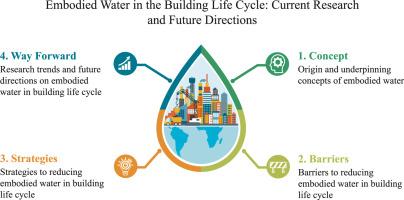建筑生命周期中的体现水:研究现状与未来方向
IF 6.4
Q1 ENVIRONMENTAL SCIENCES
引用次数: 0
摘要
水被认为是一种稀缺资源,已被纳入可持续发展目标(可持续发展目标6),并被确认为2018-2028年的水行动十年。水对建筑行业至关重要,它消耗了全球约15 - 16%的淡水。虽然水直接用于建筑,例如制备砂浆,但大量的水通过建筑材料、能源等间接消耗。直接和间接水成分的结合被称为具身水(EW)。在整个建筑生命周期内尽量减少环境污染,是推动可持续发展的必要条件。然而,EW作为评估建筑生命周期可持续性的基本要素尚未得到应有的认可,针对其重要性的研究有限。因此,本文旨在分析建筑生命周期内电子战的现状、障碍、策略、研究趋势和未来方向。为了达到本文的目的,本文采用了系统的文献综述法。本研究的结果揭示了22个阻碍电子商务减少的障碍和28个克服这些障碍的策略。高耗水材料的频繁使用、水和材料的浪费以及难以估计EW是本研究确定的一些主要障碍。选择具有低EW的材料,有效和高效地使用材料和机械,以及引入与水管理相关的政策是本研究得出的一些关键策略。此外,本文还提出了通过现有研究确定的9个研究趋势和15个前瞻性研究途径。本文章由计算机程序翻译,如有差异,请以英文原文为准。

Embodied Water in the building life cycle: current research and future directions
Water, recognised as a scarce resource, has been considered for sustainable development goals (SDG-6) and acknowledged 2018–2028 as the water action decade. Water is essential for the construction industry, and it consumes around 15–16 % of the global freshwater. While water is directly utilised for construction, for instance, in preparation of mortar, an enormous quantity of water is indirectly consumed through building materials, energy sources, etc. The combination of direct and indirect water components is termed Embodied Water (EW). Minimising EW throughout the building life cycle is imperative to drive towards sustainable development. However, EW has not yet received its due recognition as an essential element in evaluating the sustainability of the building life cycle, with limited research studies addressing its significance. Thus, this paper aims to analyse the contemporary status, barriers, strategies, research trends, and future directions of EW within the building life cycle. The systematic literature review approach was adopted to attain the aim of this paper. The results of this study reveal twenty-two barriers hindering the reduction of EW and twenty-eight strategies to overcome them. Frequent usage of high water-consuming materials, water and material wastage, and difficulties in estimating EW are some of the main barriers identified in this study. Selecting materials with low EW, effective and efficient usage of materials and machinery, and introducing water management-related policies are some of the key strategies derived from this research. Additionally, this paper presents nine research trends and fifteen prospective research avenues identified through existing studies.
求助全文
通过发布文献求助,成功后即可免费获取论文全文。
去求助
来源期刊

Resources, conservation & recycling advances
Environmental Science (General)
CiteScore
11.70
自引率
0.00%
发文量
0
审稿时长
76 days
 求助内容:
求助内容: 应助结果提醒方式:
应助结果提醒方式:


